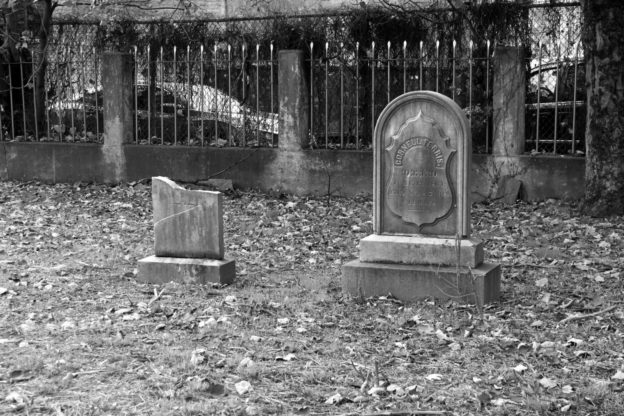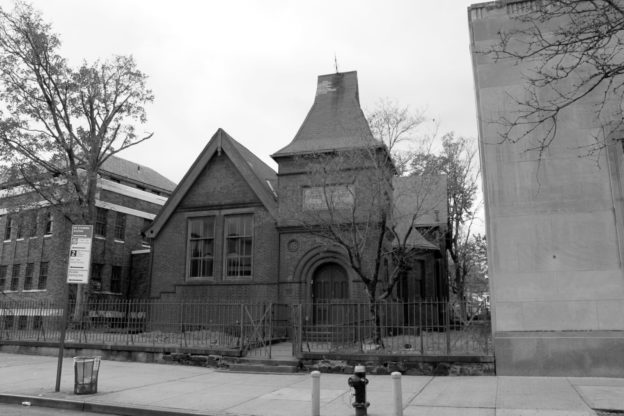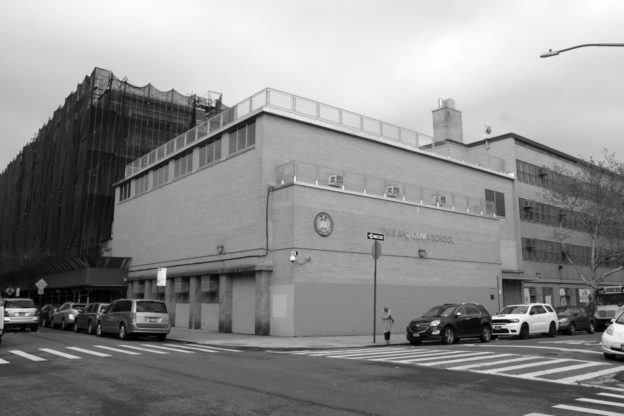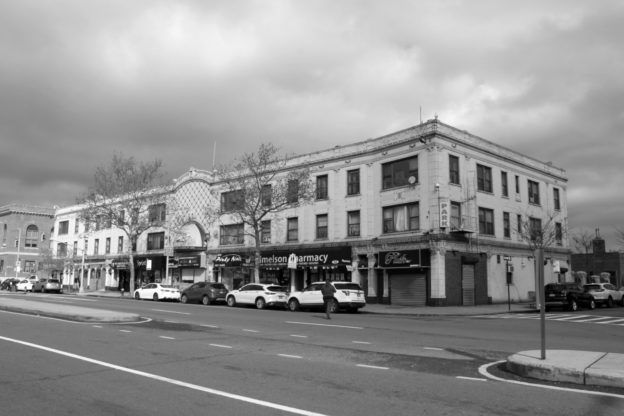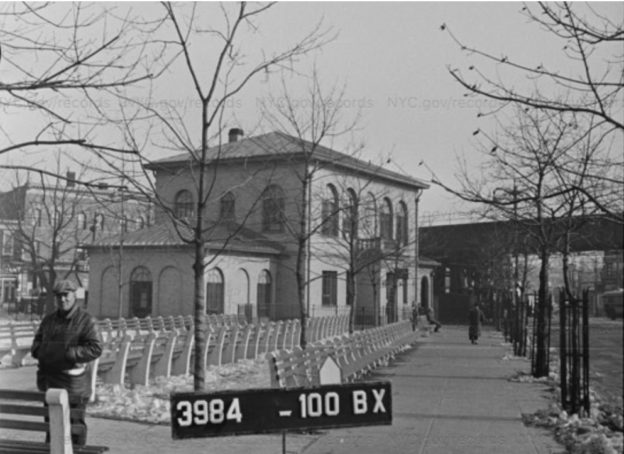Commerce Avenue
In use: 1700s – 1914
John Ferris, one of the five original recipients of the 1667 patent for the Township of Westchester, included provisions for a family burial ground in his 1717 will. The Ferris family used and maintained the cemetery for almost another two centuries until Charles Ferris passed away in 1908, leaving two vaults and around thirty gravestones to decay in an increasingly industrial setting. In 1928, the Benjamin Ferris family vault was vandalized and desecrated, prompting reinterment of almost half the bodies to Kenisco Cemetery in Westchester County. Through the ensuing decades, the cemetery has seen both periodic neglect and restoration, including the installation of a new fence in the early 2000s. Notable members of the Ferris family include James Ferris, who survived a stay on a British prison ship during the Revolutionary War and his wife, Charity Ferris, who purportedly housed British Admiral Richard Howe and transmitted strategically significant conversations to General George Washington. Whereas much of the Westchester Square was once farmlands of the Ferris family, nearby Ferris Place is the only surviving reminder in The Bronx of one of the borough’s earliest settlers.
9 Westchester Square
1882-83, Frederick Clarke Withers; Addition, 1890-92, William Anderson
The Huntington Free Library and Reading Room is one of the earliest instituions on Westchester Square and was the first library building in this part of The Bronx. The original building was designed by Frederick Clarke Withers and completed in 1883. Born and educated in England, Withers became known for his Victorian Gothic designs, epitomized by his 1874 Jefferson Market Courthouse in Greenwich Village. Commissioned by the executors of the estate of tobacco merchant Peter C. Van Shaick, who left $15,000 for the construction of a free reading room for Westchester and in honor of his wife, Anna Mitchell Van Shaick, who died in 1876. The building sat vacant after the town government refused to accept the gift due to its limited endowment. In 1890, Collis Potter Huntington, a railroad magnate with a summer home in nearby Throggs Neck purchased the building, expanded it, and endowed it with funds to cover its operating expenses. The building is entered through an arched doorway set within a one-bay tower, which features a terra cotta plaque and rondels that commemorate Huntington’s donation. The Huntington Free Library was designated as a NYC Individual Landmark in 1994 as the “Van Shaick Free Reading Room / Huntington Free Library and Reading Room”.
12 Westchester Square
1942
Cross & Cross
Originally a Federal Revival style building, in 1940 architects Cross & Cross updated the structure to relfect the latest architectural fashion of the time. The architects employed stylized classical elements such as a sawtoothed balustrade and fluted pilasters which flank the entrance in a Streamline Moderne expression. A integral clock adorns the facade, with gemoetric shapes in place of numbers set within carved ribbing. This edifice still features its original name — The Bronx Savings Bank — carved into stone beneath the contemporary Apple Bank for Savings signage that currently exists. A local banking institution, The Bronx Savings Bank operated from 1905 until 1974, which branches throughout The Bronx and Westchester County.Cross & Cross were a prolific firm who designed many distinguished Art Deco skyscrapers such as the General Electric Building, Twenty Exchange Place and 90 Church Street, all in Manhattan.
2555 Tratman Avenue
1966; 1910 Annex
Although its current home was constructed in 1966, Public School 12’s history stretches back to include at least three buildings in the vicinity of Westchester Square. The first PS 12, replete with a spire-topped tower, was completed in 1886 and stood at the current site of the playground on Frisby Avenue. A later addition to the original structure, built around 1910, was designed in the Renaissance Revival style and still stands as an office annex connected to the four-story, yellow-brick Modern style classroom building, built in 1966. This building was the city’s first school building purpose-built for the specialized education of students with behavioral issues. This building is divided into two architectural components: the corner portion, which features minimal fenestration, blank brick walls, and the school entrance; and the classroom wing, with the upper three stories characterized by contrasting bands of windows and panels. Interestingly, one of PS 12’s most beloved and longest-serving principals, Dr. John Condon, made headlines in 1932 as the designated intermediary between Charles Lindbergh and the kidnappers of his child.
2626 East Tremont Avenue
ca. 1912
This three-bay, three-story building features a limestone facade and pedimented entryway. The building was originally constructed as the Wyoming Masonic Temple to host the local Wyoming Lodge of the Free & Accepted Masons (“Freemasons”). Legend holds that as a Westchester Lodge already existed, members selected the name “Wyoming” after randomly pulling a bank note issued by the Pennsylvania-based Bank of Wyoming. While the exact date of construction is unknown, the Wyoming Masonic Temple is referenced as a venue for Freemasons as early as 1912. Historic photographs demonstrate that while the Freemasons consistently occupied the upper floors of the building, the ground floor space was rented to a range of tenants over the years. With international roots that stretch back centuries, the Free & Accepted Masons is a fraternal organization that focuses on civic engagement, which is demonstrated by the variety of community events advertised at the Wyoming Masonic Temple over its long history. Of the seven masonic temples that originally served The Bronx, six remain standing. Only the City Island Temple retains its original function, housing the Wyoming Lodge along with the three other lodges currently active in the borough.
44 Westchester Square
ca. 1921
Known locally as “The White Elephant,” this three-story white brick structure stretches the entire length of a prominent block. The monochrome brick is complemented by a striking variety of multicolored glazed terra cotta, including a band above the first floor retail fenestration and diamond patterning that covers the entirety of the facade above the building’s main entrance. Interestingly, the central archway, now occupied by a retail storefront, once opened inward to feature a round arched hallway lined with tilework. Although this structure never served as a theater, one may infer the building’s intended use from the terra-cotta detailing, which includes representations of theatrical masks and instruments. The White Elephant has hosted a variety of tenants over its long history, including cafes, realtors and an office of The Bronx Gas & Electric Company.
Lane Avenue & Westchester Square
1925, John Oakman
Dedicated in 1925 and relocated to this spot in the early 1940s, this fifteen-foot-high pink granite monument was donated by the “people of Westchester” to honor local residents who served in World War I. This monument takes the form of a pylon: It is rectangular in plan, grounded on a plinth and tapering in tiers to culminate with a cornice. The memorial carries the inscription: “To perpetuate in grateful remembrance the sacrifice, heroism, and devotion of the men and women of the old town of Westchester who in the World War answered the call of their country that justice and righteousness should not perish.” Along with listing the names of soldiers who died in the war, the monument carries the names of the battles in which they perished, including the Battles of Cambrai, the Somme, and Vittorio Veneto, among others. Owen F. Dolen, a local educator who led the six-year initiative to construct the monument, gave a twenty-five minute speech at its dedication ceremony before suddenly dying of a heart attack minutes later. This monument is one of 103 memorials in New York City parks dedicated to those that served in World War I.
2551 Westchester Avenue
Park: 1907; Recreation Center: 1927; Alterations: 1983, John Ciardullo
Acquired by the city through two purchases in 1907 and 1909, this park was known as Westchester Square until 1925, when it was renamed after Owen Dolen, a local educator who died after speaking at the dedication ceremony for the park’s World War I monument. Benson Street divided the two parcels of this park until 1993, at which point a portion of the street was closed and replaced with vegetation that expanded the footprint of the park. The recreation center, built in 1927, was initially designed to serve as the park’s comfort station before being converted to a branch of the New York Public Library in the 1930s. Designed with elements of the Spanish Revival style, the recreation center consists of a two-story, five-bay central building and two three-bay, one-story wings, all of which are characterized by large round arch windows and entryways. In 1982, the New York City Department of Parks & Recreation hired John Ciardullo Associates to redesign the building for use as the Owen Dolen Golden Age Center, which included a new entryway with a triangular facade built of architectural concrete, as well as ample space for programming serving senior citizens.
Photo courtesy of NYC Municipal Archive.
2551 Westchester Avenue
Owen F. Dolen Park
1987, David Saunders
David Saunders designed this bronze sculpture, sited on a base of engraved Stony Creek granite. Dedicated in 1987, it references 19th century monuments that often featured a seated figure. Seat encourages viewers to consider themselves in the chair and is thus a monument to everyone. Beneath the chair rests a dictionary open to a plate depicting the “Common Birds of America”, while the granite boulder itself is engraved with imagery of a wild boar with her four piglets on the sides. Commissioned by the Public Art Fund, Seat was the winner of the New York City Art Commission’s 1985 Excellence in Design Award. David Saunders, a native New Yorker, has completed public sculptures displayed both elsewhere in The Bronx and abroad and has work featured at the Museum of Modern Art and Metropolitan Museum of Art, among others.
East Tremont Ave. & Westchester Ave.
1920
Squire J. Vickers
Completed in 1920 as part of the Dual Contracts subway system expansion, the Westchester Square — East Tremont Avenue station sits on the Interborough Rapid Transit Company’s Pelham Line, which stretches from the South Bronx to Pelham Bay Park. Westchester Square had retained the feel of a rural village center until the arrival of the subway, upon which the area rapidly developed into a residential commuter community with a variety of housing stock. A 1916 Public Service Commission report on the plans for the Pelham Line outlines the construction of three ornamental concrete stations, including one at Westchester Square, as well as a fixed bridge spanning The Bronx River and New Haven Railroad right of way. This elevated station consists of a steel frame structure and concrete facade, with a stair tower on the western side decorated with inlays of blue, green and orange ceramic tiles arranged in geometric patterns. Squire Vickers, who designed a majority of stations constructed as part of the Dual Contracts and Independent Subway Systems, was known for his utilitarian spaces complemented by colorful tilework. The interiors of the station mezzanine and stair tower were renovated in 1993 to include new terrazzo floors, ceramic wall tiles, glass block openings and a new stained glass window titled City of Light and designed by Romare Bearden. The Westchester Square — East Tremont Avenue station is listed on the State and National Register of Historic Places.

